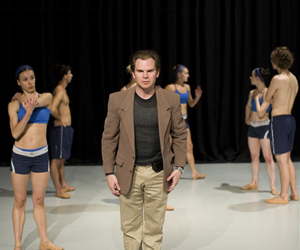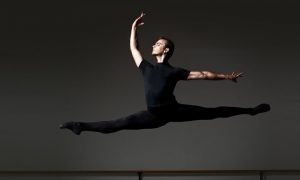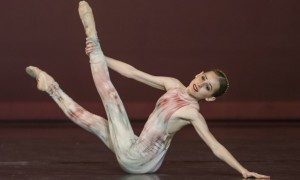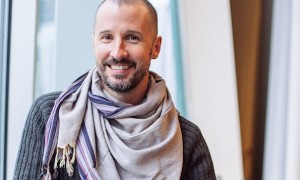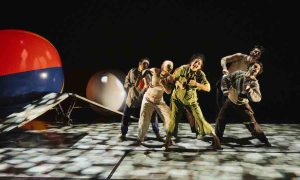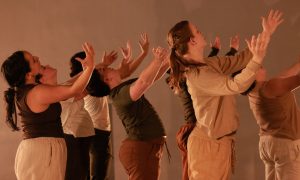Resident Choreographer, Melbourne Ballet Company
By Rebecca Martin.
From eleven years of age Simon Hoy trained in the Vagonova ballet style and at 16 was accepted into The Australian Ballet School. During the next three years at the ABS he gained much experience dancing leading roles in the school’s productions of Napoli, Sleeping Beauty, The Snow Queen and Trios. He was chosen to represent the Australian Ballet School in his second year at the Royal Academy of Dance Gala in Osaka, Japan and performed the Peasant Pas de Deux from Rudolf Nureyev’s production of Giselle. Simon toured with The Australian Ballet’s ‘The Dancers Company’ in his final year at the school, graduating in 1997 with an Advanced Diploma in Dance.
Since then Simon has worked as a soloist and danced Principal roles with Ballet Graz in Austria, Ballet Mainz in Germany, Schaufuss Ballet in Denmark, Carolina Ballet and Cedar Lake Contemporary Ballet in New York. He has toured throughout the United States, Europe and Asia working with many outstanding ballet masters and choreographers and has performed works by George Balanchine, Frederick Ashton, and John Cranko. Since returning to Australia Simon has played a leading role in the renaissance of the Melbourne Ballet Company as its resident choreographer, and has so far created six new works for the Company. Simon spends much of his time working overseas but is based in Melbourne where he has just wrapped up a successful sixth season with Melbourne Ballet Company.
Simon found the transition from dancer to choreographer to be a natural progression. “When working on a new piece I’m very influenced by my background as a classically based dancer. I am especially inspired by the music chosen, and also the sheer physicality of dance. But I try not to over intellectualise the process and let the language of dance speak for itself. There are many similarities between a dancer and a choreographer, and I think that in most professional dancers there is a choreographer and in most choreographers there is a dancer. Sure, you can be both, but in reality only one at a time. The choreographer necessarily has a different perspective from the dancers, more holistic perhaps”.
 Long before the dancers arrive at rehearsals, Simon has been in the studio alone preparing his pieces and familiarising himself with the music. “My process always starts with a certain amount of time spent developing choreographic concepts and material. My work is quite technically based so I need to know that I’m not recreating a ballet that I created last month. It takes a bit of work to go down a path that is in many ways a result of what has been done before but is not the same. Often you spend a lot of time with a certain amount of content and it becomes embedded in you and then you create a new work and you start to choreograph what you have already choreographed”. Despite beginning the creative process alone, Simon believes it is important for the dancers to be involved in the development of a new work. “I am very aware of the vocabulary I am creating myself and for the most part can explain the choreographic line or the language. I feel that if I let the creative process get too out of my hands, I lose that. While the dancers I work with may bring a more creative approach to the work, I need to hold onto my own choreographic line. I need to understand it myself, I need to be able to feel it in my own body, in order to move onto the next part of the piece. Often somebody will say ‘what about this?’ which is great, but I don’t know where that came from, and I’m not quick to say ‘yeah let’s keep that, I like it’ because I need to know why you put that there. I develop a concept in my head before working with dancers and then look at what the dancers bring to it. Dance is a language and most choreographers have their own language that fundamentally needs to stay clear and true to themselves. When I go into the studio I need to understand the music in regard to phrasing and know the counts and exactly what I want in terms of narrative or motive, and for the most part I know what steps I want. Maybe that will change, but for now that is how it is for me”.
Long before the dancers arrive at rehearsals, Simon has been in the studio alone preparing his pieces and familiarising himself with the music. “My process always starts with a certain amount of time spent developing choreographic concepts and material. My work is quite technically based so I need to know that I’m not recreating a ballet that I created last month. It takes a bit of work to go down a path that is in many ways a result of what has been done before but is not the same. Often you spend a lot of time with a certain amount of content and it becomes embedded in you and then you create a new work and you start to choreograph what you have already choreographed”. Despite beginning the creative process alone, Simon believes it is important for the dancers to be involved in the development of a new work. “I am very aware of the vocabulary I am creating myself and for the most part can explain the choreographic line or the language. I feel that if I let the creative process get too out of my hands, I lose that. While the dancers I work with may bring a more creative approach to the work, I need to hold onto my own choreographic line. I need to understand it myself, I need to be able to feel it in my own body, in order to move onto the next part of the piece. Often somebody will say ‘what about this?’ which is great, but I don’t know where that came from, and I’m not quick to say ‘yeah let’s keep that, I like it’ because I need to know why you put that there. I develop a concept in my head before working with dancers and then look at what the dancers bring to it. Dance is a language and most choreographers have their own language that fundamentally needs to stay clear and true to themselves. When I go into the studio I need to understand the music in regard to phrasing and know the counts and exactly what I want in terms of narrative or motive, and for the most part I know what steps I want. Maybe that will change, but for now that is how it is for me”.
So what motivates and inspires him to create new dance pieces? “Above all, I am inspired by music. I don’t necessarily need a score to hear the music; it’s more about finding a rhythm within (finding a pulse). Through my work I try to speak with a classical voice. Line and shape are very important to me. A lot of the material I tend to develop alone listening to many, many, repetitions of the music while searching for a dance structure, and only then moving to translate the work for the dancers. The motivation to create is instinctual and subconscious and derived from a life time of experiences that cannot always be pinned down. It is circumstance and the nature of existence. Choreography is a language in which some people choose to express themselves and all the rest of it is just business. You are not given a performance based platform where there is no judgment or review at the end of the day. I enjoy a response from an audience, I enjoy communicating to an audience and I enjoy the process with the dancers but whenever there is a conclusion or review at the end of it all you cannot dismiss the business side of things but you can be aware of that while remaining true to your work”.
While there is much contention over what constitutes art, and whether it exists to entertain, Simon believes that art is entertainment resulting from a line of communication between artist and audience. “Art is such a general term covering music, opera, dance, television, movies, fashion, literature or poetry, but it has to entertain on some level. It has to stimulate you and for me being entertained and stimulated is relatively aligned. As an artist you don’t necessarily have to be aware of entertaining an audience but you do need to understand fundamentally that what you are doing or creating is a source for people to respond to. You need to communicate with the audience and ultimately, I think art is communication. When I respond to art it is because it has entertained me on some level”.
“As a dancer I was lucky enough to be exposed to a lot of very influential choreographers, directors, teachers and dancers and I enjoyed my years dancing very much. I enjoyed performing, but above all I enjoy being a student of this craft that is so perfect. It is a wonderfully simple technique in so many ways but impossible to master. Classical dance is a wonderful voice to use”. At the conclusion of his dance career, Hoy chose to continue using the voice of dance. “My inspiration above all is my absolute respect, passion, lifelong commitment and love for dance. I simply have a personal approach to the philosophy, technique and language of dance. I can take about five percent of the credit for what I create – whoever created ballet over the centuries takes the other 95 percent. I will do anything in my power to continue to speak the language of dance. It is a difficult thing though, because there are very few people that can support themselves financially as a choreographer, but where there is an audience, there is a way. In Australia we have a very educated and diverse audience that is open to supporting new works. Melbourne is a great place to create works with a generous and responsive audience and I think it is a city that can continue to be the home of many creations”.
Melbourne Ballet Company’s next performance season will be Project Seven – “Infinite Space” from June 3rd to 13th.
For further information about Melbourne Ballet Company visit www.melbourneballetcompany.com.au
Top photo: Michelle McLellan


